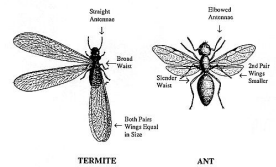 |

 Insect swarms and fruit spray programs
Insect swarms and fruit spray programs
By John Fulton
[May 13, 2011] With some warmer weather come the swarms of insects that raise the perennial question, "Are they ants or termites?" Swarming time for both insects is about the same, and they are really looking to start new colonies because they have outgrown their old ones. This is the reason for the winged insects, as the wings allow the ants or termites to cover larger areas to start their new colonies.
|
The differences between ants and termites are several. Let's start with the body color. Termites are always blackish in color, while ants may be black, red, brown or other colors. If you have winged insects that are not black, you don't have termites. Next, look at the body shape. Ants have a constricted "waist," while termites don't have that classic "hourglass" figure. Antennae and wings are the other two body parts to look at. Antennae on ants are elbowed, basically in an "L" shape, and those on termites are straight. Both ants and termites have two pair of wings, but those on termites will be of equal length, while ants will have wings of different lengths on each side. Looking through those entomology fact sheets also brings up a few important points in the event that you do have termites. First, don't assume that the house will fall in overnight. Take the time to get several bids for the treatment from reputable companies. Make sure you compare cost, service and guarantees. Second, termites are pretty much a professional treatment job, unless you have an exposed foundation such as in a new construction project. Third, there are traditional treatments to kill the insects, and other treatments render them incapable of reproducing. Drenches, pressure injection and bait stations are all options. If ants are your problem, use of bait stations or baseboard sprays may help solve your problems. Many of the bait station programs will require a good week to 10 days to be effective. Remember that damage done by ants, even carpenter ants, is not structurally damaging to your home. They simply make a nesting hole in wood rather than digest it. If you have further questions on termites, or if the do-it-yourself identification doesn't seem to work, by all means contact the Extension office at 732-8289. Spray programs For most of your fruit trees and also your crab apples, spray programs should have begun when the leaf buds started to open. According to the pest control handbook, sprays should continue on about a 10-day schedule until within two weeks of harvest for fruits and until fruit sets on crab apples. For the homeowner, a multipurpose fruit spray is the easiest product to use. It contains two insecticides and a fungicide. Because of toxicity to bees, just remember to avoid spraying insecticides on flowering plants -- like right now on apples. You can substitute plain captan fungicide during flowering to continue your disease control. Keep in mind that these types of sprays are preventive in nature. That means you need to have the sprays in place before you have problems. Once problems appear, there is very little that can be done. If you want more information on spray programs, feel free to stop by the office and pick up a copy of the "Home Fruit Pest Control" publication, available at no charge. While the insecticides have changed, the timing has not. [By JOHN FULTON, University of Illinois Extension]
|
 |




